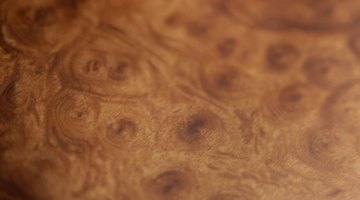How to Create a Faux Burl Finish
A faux burl finish takes the techniques from general faux wood graining and gives them a complex, high-end look. Burled wood, or burl wood as it is sometimes called, is an irregular growth on a tree that, when sliced, shows no specific grain direction.

When sanded and polished, the end result is a finish with numerous curls and swirls. Study actual burl wood to mimic the patterns and colors for an ideal faux finish. Sand, clean and prime your project piece with a latex primer before attempting the faux burl work.
-
Cover the work area with newspaper. Set the project piece atop the paper.
-
Cover any areas you don't wish to paint with painter's tape.
-
Open the can of the lightest-colored latex paint. Stir it with a paint stirrer, and pour some into a paint tray. Choose a paint color with a yellowish or slightly orange wood tint, depending on the type of burl wood you wish to copy.
-
Dip a paintbrush into the paint tray and use it to coat the project piece. Apply the paint in even, overlapping strokes. Allow the paint to dry completely; apply a second coat and allow it to dry if the primer shows through the first paint layer.
-
Pour clear latex glaze into a clean paint tray, stirring in 1/4 to 1/3 as much of each of the two additional latex paint colors. For the secondary paint colors, opt for wood tones with slightly orange or reddish tints to create a warm burled wood finish.
-
Dip a paintbrush into the glaze mixture and brush it over the project using wavy strokes. Overlap strokes -- they do not need to be parallel, as burled wood curves randomly.
-
Blot a sea sponge or ball of cheesecloth gently and randomly over the glazed project. Brush lightly with a dry feathering brush to soften the look a bit, wiping excess glaze onto a rag to keep the brush dry.
-
Pour a little of the darkest paint color into a disposable container, adding a similar amount of clear glaze. Stir the liquids together. Do the same with the other dark paint color in a separate container.
-
Dip a round artist's brush or stencil brush into the lighter of the two dark glazes; then pounce the brush over the glazed project piece to create sparse, random circles. This can be done while the project is wet or dry. Dip a small artist's brush into the darker glaze and make a few dots over the dark circles. Allow the glazes to dry.
-
Shove a comb through the bristles of a paintbrush to separate the bristles a bit. Dip the brush, with comb intact, into the original glaze used in Step 5. Brush wavy lines over the entire project to create curved wood grain. This step may be skipped if the original wavy lines are strong enough that they resemble wood grain. Allow the glaze to dry completely.
Things You Will Need
- Newspaper
- Painter's tape
- Satin latex paint in light wood tint
- Paint stirrer
- Paint trays
- Paintbrush
- Latex paint in 2 darker, warm wood tones, such as burnt orange and raw sienna
- Sea sponge or cheesecloth
- Rags
- Disposable containers
- Large round artist's brush or stencil brush
- Fine artist's brush
- Comb
Tip
Pair a faux burl finish with other faux wood finishes for a beautiful effect; an entire dresser done with a burl finish may look a bit overdone, so burl the top and dresser drawer fronts instead, using faux wood grain for the rest of the dresser. True burl wood is hard to come by and generally covers small areas since the burls themselves are not as wide or tall as the trees they came from. Apply a coat of polyurethane over the completed project if you wish to protect your work.
Warning
Practice your faux burl technique on cardboard before attempting it on a prized possession. Honing your technique ensures the color combinations and depths look the way you intend; plus, your confidence results in a better finish on the actual project piece.
References
Writer Bio
Kathy Adams is an award-winning journalist and freelance writer who traveled the world handling numerous duties for music artists. She writes travel and budgeting tips and destination guides for USA Today, Travelocity and ForRent, among others. She enjoys exploring foreign locales and hiking off the beaten path stateside, snapping pics of wildlife and nature instead of selfies.
Photo Credits
- Brand X Pictures/Stockbyte/Getty Images
- Brand X Pictures/Stockbyte/Getty Images
More Articles



